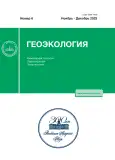GEOFILTRATION MODELING OF WATER FLOWS TO PRODUCED PRIMARY DIAMOND DEPOSITS AND INJECTION IN ASSOCIATED AREAS
- 作者: Yannikov A.M.1, Struchkova A.S.1
-
隶属关系:
- Yakutniproalmaz ALROSA PJSC
- 期: 编号 6 (2023)
- 页面: 71-78
- 栏目: MODELS IN ENGINEERING GEOLOGY AND HYDROGEOLOGY
- URL: https://journals.rcsi.science/0869-7809/article/view/233681
- DOI: https://doi.org/10.31857/S0869780923060097
- EDN: https://elibrary.ru/AONHQB
- ID: 233681
如何引用文章
全文:
详细
Safe development of primary diamond deposits in Western Yakutia requires constant monitoring of the hydrogeological regime of the exposed aquifer complexes within the quarry and mine fields of the deposits, as well as in the adjacent areas of drainage water injection. Over the entire period of development of the Alakit-Markhinsky, Daldynsky, Mirninsky and Nakynsky kimberlitic fields, about 400 million m3 of highly mineralized drainage water from quarries and mines were involved in the pumping-injection process. Complex cryohydrogeological conditions of the territory, i.e., lithological-facial specifics, continuous distribution of permafrost, structural confinement of kimberlite fields, fault-block structure of individual pipes, influence the dynamics of occurring changes and make the cryohydrogeological conditions of each individual pipe unique and having no complete analogues. In order to predict successfully and implement subsequently technical solutions aimed at controlling inflows of all types formed within mine and quarry fields, the Yakutniproalmaz Institute elaborated a program for the development, constant maintenance and updating of hydrogeological “digital twins” of all key mining deposits. The developed models take into account the influence of both natural factors and the applied schemes for opening and draining deposits, which impose their own limitations. The filtration problem was solved out using the licensed program FEFLOW, which performs modeling of hydrogeological conditions by the finite element method in a multilayer strata for areas of arbitrary configuration with boundary conditions of type I, II, III changing according to the known law in the presence of filtration heterogeneities in plan and section, as well as vertical filtration. The creation and constant updating of permanent digital models made it possible not only to acquire a modern tool for forecasting water inflows, but also helped to improve the planning process in terms of drilling drainage and injection wells, purchasing pumping equipment, etc. Deviation of predicted values from those actually observed within the short-term forecast for the period of use 2021–2023 ranged from 5 to 10%.
作者简介
A. Yannikov
Yakutniproalmaz ALROSA PJSC
编辑信件的主要联系方式.
Email: yannikov90@mail.ru
Russia, Republic of Sakha (Yakutia), Mirny,
ul. Lenina, 39
A. Struchkova
Yakutniproalmaz ALROSA PJSC
Email: yannikov90@mail.ru
Russia, Republic of Sakha (Yakutia), Mirny,
ul. Lenina, 39
参考
- Gavich, I.K. [Fundamentals of hydrogeological stratification and information processing]. Moscow, MGRI Publ., 1982, 79 p. (in Russian)
- [Hydrogeology of the USSR. Vol. XX. Yakut ASSR]. Moscow, Nedra Publ., 1970, 384 p. (in Russian)
- Drozdov, A.V., Iost, N.A., Lobanov, V.V. [Cryohydrogeology of diamond deposits in Western Yakutia]. Irkutsk, IGTU Publ., 2008, 507 p. (in Russian)
- Klimovskii, I.V., Gotovtsev, S.P. [Cryolithozone of the Yakutsk diamondiferous province]. Novosibirsk, Nauka Publ., 1994, 167 p. (in Russian)
- Klimovskii, I.V., Gotovtsev, S.P., Shepelev, V.V. [Hydrogeocryological conditions of the landfill for underground burial of drainage waters from the “Udachnaya” pipe]. Kriosfera Zemli, 2002, vol. VI, no. 3, pp. 45–50. (in Russian)
- Kolganov, V.F., Akishev, A.N., Drozdov, A.V. [Mining and geological features of primary diamond deposits in Yakutia], Mirnyi, Mirninskaya tipografiya Publ., 2013, 568 p. (in Russian)
- Yannikov, A.M. [Hydrogeology of the Mirny kimberlite field]. Mirnyi, ZYaNTs/YaNA Publ., 2021, 240 p. (in Russian)
- Yannikov, A.M., Zyryanov, I.V., Korepanov, A.Yu., Struchkova, A.S. [Dynamics and forecast of changes in the hydrodynamic regime of the Lower Cambrian aquifer within the Daldynskaya flexure]. Gornyi informatsionno-analiticheskii byulleten’ (nauchno-tekhnicheskii zhurnal), 2022, no. 9, pp. 60–73. (in Russian)
- Yannikov, A.M., Brychaev N.M. [Using natural and man-made blind taliks as backup sources of water supply (a case study of a section of the Sytykan river valley, Republic of Sakha (Yakutia))]. Vestnik Voronezhskogo gosudarstvennogo universiteta. Seriya: Geologiya, 2022, no. 4, pp. 118–126. (in Russian)
- Bidwell, V.J. Realistic forecasting of groundwater level, based on the eigenstructure of aquifer dynamics. Mathematics and Computers in Simulation, 2005, vol. 69, issues 1–2, pp. 12–20, https://doi.org/10.1016/j.matcom.2005.02.023.
- Pouladi, B., Bour, O., Longuevergne, L., Bernardie, J. de La, Simon, N. Modelling borehole flows from Distributed Temperature Sensing data to monitor groundwater dynamics in fractured media. Journal of Hydrology, 2021, vol. 598, 126450. https://doi.org/10.1016/j.jhydrol.2021.126450.
- Zhao, C., Wang, Y., Chen, X., Li, B. Simulation of the effects of groundwater level on vegetation change by combining FEFLOW software. Ecological Modelling, 2005, vol.187, nos. 2–3, pp. 341–351. https://doi.org/10.1016/j.ecolmodel.2004.10.019












